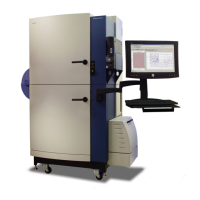FLIPR
®
Tetra High Throughput Cellular Screening System User Guide
0112-0109 H 191
Preparation of Cell Reservoir and Running the Assay
1. The Cell Reservoir must have been cleaned at the end of the
previous day’s assay. If this was done, rinse with DI H
2
O, several
times.
2. If the Cell Reservoir was not cleaned after previous assay, follow
instructions for making AquaMax Sterilant Kit Procedure (Cat#
R8156, Molecular Devices). See Appendix C.
3. Fill a flask with the sterilant solution and run 3–4 Cell Reservoir
wash cycles including a 2 minute soak (Hold Time = 120 s).
4. Physically wipe the Cell Reservoir with Kimwipes moistened in DI
water.
5. Rinse the Cell Reservoir 5 times with DI water and follow the
steps for preparation in #6.
6. Prior to start of assay, Cell Reservoir and lines to and from
spinner flask should be rinsed 5X each with the following:
70% Ethanol
Endotoxin-free DI water
Media containing BSA-Medium 0.1% BSA
7. Prior to start of screening, insert the hard plastic tubes from the
Cell Flask into the lines running from the 8-way valve by
pinching the lines and sliding the tubing inside.
8. Cycle the cells through to the Cell Reservoir two to three times
prior to starting assay.
9. Use 2–3 plates to prior to screening and insure that the camera
settings are within range of the signal.
If cells are recirculated back to the cell flask, it is strongly
recommended that the tips be washed each time an assay is run to
reduce risk of contamination of the cells by toxic or antagonist
compounds.
Instrument Setup
Luminescence assays require no excitation source, but do require
optimal instrument conditions to collect the maximum amount of light
emitted from the assay. These settings are specific to the Aequorin
camera option.
In order to provide optimal light collection by the FLIPR
®
Tetra System,
we recommend you leave an empty emission filter position in the filter
slider to run aequorin. In addition, you must calibrate the instrument to
use no LEDs and emission filters. This state is identified as the
NONE/NONE Excitation/Emission Wavelengths. Detailed instructions
outlining the removal of the emission filters and calibration are found in
Exchanging Hardware on page 129.

